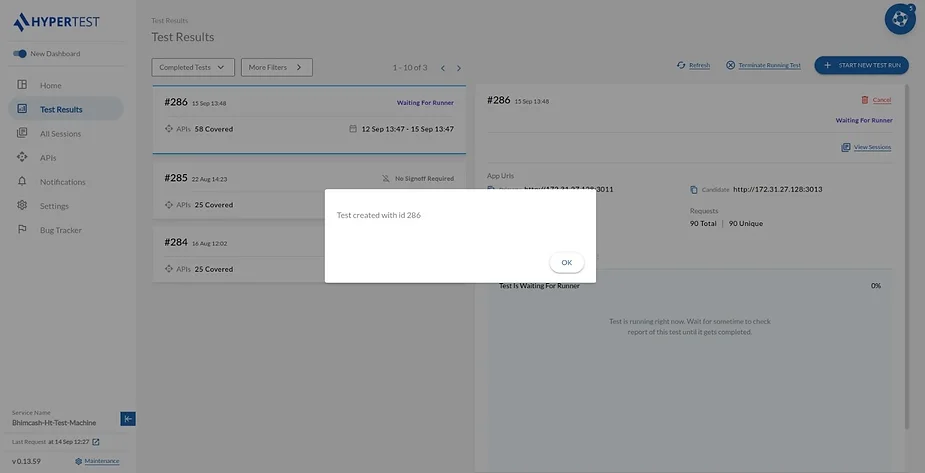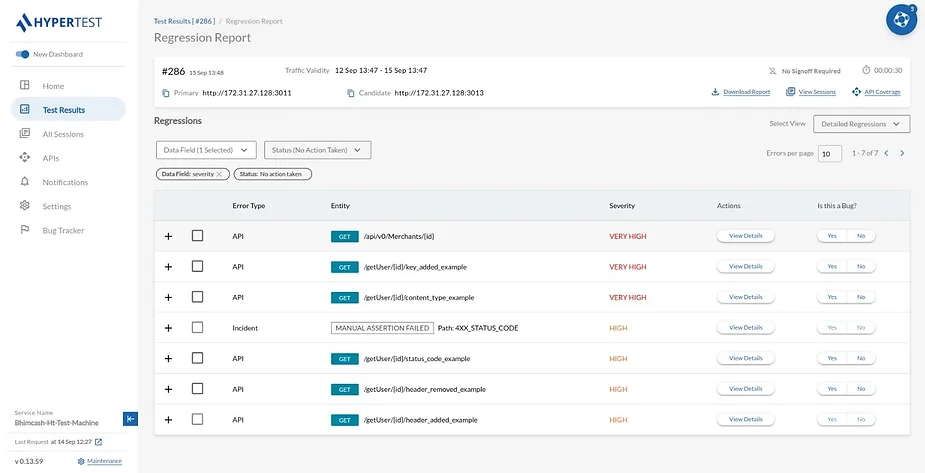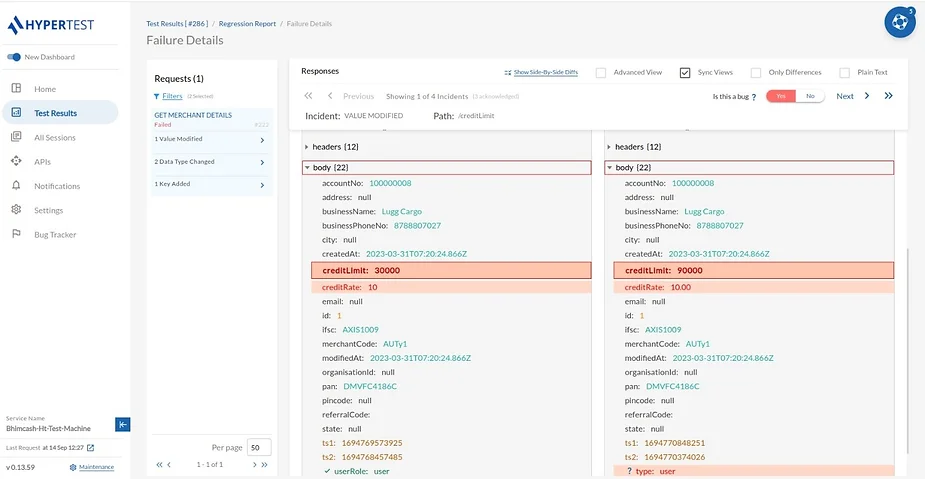20 October 2022
9 Min. Read
Mobile App API Testing
How to perform Mobile App API Testing to achieve zero-downtime?


Key Highlights
In this blog, we cover following key highlights
Learn about what is Mobile App API testing and its challenges
Get to know how it can be performed efficiently
Learn about the tools that are highly used and best suitable for testing APIs for mobile apps
Know how exactly to perform mobile app API testing with HyperTest
In this blog post, we'll discuss the most effective tools to do mobile app API testing, along with a step-by-step guide to perform it yourself.
If you're familiar with mobile app development, you would know how integral APIs have become for businesses, making sharing services easy and accessible on all devices and platforms.
As much as API is fundamental to mobile applications, it is essential to ensure API quality and smooth functioning through effective testing throughout the evolutionary phase.
While checking on the API functionalities, API testing also validates secure and highly reliable performance, letting developers keep an eye on potential vulnerabilities and performance issues in the initial stages of testing and deployment.
What is Mobile App API Testing?
Implementing API testing automation for mobile apps is carried out by DevOps, and quality assurance (QA) teams as part of regular testing routines. The test is done by initiating requests to single or multiple API endpoints and comparing the response with the expected results.
API testing generally follows the below steps:
Set up the Testing Environment
Write Test Cases
Run the Tests
Analyze the Results
Repeat as Necessary
Mobile app API testing is typically performed in a separate testing environment that simulates the production environment. This allows developers to focus on testing the API without having to worry about the application's other dependencies.
Once the testing environment is set up, developers will write test cases that exercise the API and assess its functionality. These test cases can be run manually or automatically.
After the tests are run, the results are analyzed to identify any issues. If necessary, the process is repeated until all issues have been resolved.
Types of Mobile App API Testing
Mobile App API testing can be performed manually or automated. Manual testing can be useful for exploratory testing or when you're first getting started with a new API. But automated tests are faster and more reliable, and help to identify issues more quickly. Automated tests are conducted by special testing tools.
There are various types of Mobile App API testing, each with its own purpose, the most common categories being functional, load, security, and compliance tests.
Mobile App API Functional Testing
Mobile API Functional tests focus on the API's functionality and ensure that it responds as per the expectations and within the set protocols. One can use data-driven testing for vast amounts of input data and respective output, or leverage keywords for test harnesses at a higher level. This test examines specific methods inside the codebase.
Mobile App API Load Testing (or performance testing)
Mobile app API Load testing ensures that an API can handle a high number of requests without experiencing any degradation in performance. This type of test is important for ensuring that the Mobile API will be able to handle peak traffic periods without any issues. It is conducted using Mobile API Load Testing tools.
Mobile App API Security Testing
Mobile App Security testing focuses on assessing the security of an API and its data. This includes tests for vulnerabilities such as SQL injection and cross-site scripting (XSS). These tests can be used to ensure that the Mobile App API is properly configured and that sensitive data is protected.
Mobile App API Compliance Testing
Mobile App Compliance testing assesses whether an API adheres to certain standards or regulations. This type of test is important for ensuring that the Mobile App API meets industry-specific requirements.
Mobile App API Fuzz Testing
Mobile App Fuzz testing is a type of security test that involves providing invalid or unexpected input to an API in order to assess its resilience. This type of test is important for identifying potential security vulnerabilities in Mobile App APIs.
Ways to perform Mobile App API Testing
In case of testing mobile app, both the frontend and backend should work in collaboration to provide a seamless user experience. But all the working logic is carried over by the APIs working in the backend. So to make sure the smooth functioning of any app, it is highly relevant to test not only the frontend, but also the backend, i.e., the APIs.
Like any other backend testing, mobile API testing can also be performed using a number of ways. Manual testing is one primary method to test APIs, which is rapidly getting taken over by the automated testing as the development teams focusses more on agility. There are numerous tools available in the market to perform automated testing, thereby complimenting the already fast-moving nature of automation.
Tools To Perform Mobile App API Testing
Since the API-driven market is expanding exponentially, new API automation tools are coming every now and then. Let’s take a quick look at some of the most talked about mobile API testing tools based on the features, usage, experience and the performance provided by them.
📶 Nearly 90% of developers use APIs in their work, with 69% relying on third-party APIs and 20% using internal or private APIs
1️⃣ HyperTest
HyperTest is the go-to choice for thousands of agile teams, including major players like Groww, Nykaa, and PayU. It acts as the last line of defense, preventing regressions caused by code changes.
It leverages your mobile app API traffic for auto-generating integration tests, making testing processes at every new commit more feasible.
Benefits of HyperTest for Mobile App API Testing
Generates test-cases based on real network requests: HyperTest monitors all the network requests coming to your mobile app, and uses them to auto-generate test cases around them, covering every user-flow to get tested.
Provides E2E coverage: Since the test cases are essentially the path taken by a user while browsing your app, HyperTest will cover it in an end-to-end manner. Providing maximum coverage in testing all the user flows, and not missing out on any.

No-code solution to generate integration tests: HyperTest has developed a unique approach that can help developers automatically generate integration tests that test code with all its external components for every commit, without keeping any of the dependent service up and running.
Integration with CI/CD Pipeline: Agile teams demand speed, and CI/CD integrations are a keen factor for their success. HyperTest seamlessly integrates with any CI pipeline, catching every logical error and helping devs sign-off releases in an accelerated manner.
HyperTest has a native CLI utility that integrates with any CI tool like Jenkins, GitLab CI, Bamboo, CodeShip, Circle CI, Buildbot, Integrity, Buddy, TeamCity, GoCD, Strider, etc.
Website: https://www.hypertest.co/
2️⃣ Postman
Postman is a well-known tool when it comes to API testing. Its been here for a long time now, offering robust API testing solutions that big names like WhatsApp, Axis Bank are already leveraging.
Benefits of Postman for Mobile App API Testing
Diverse Protocol and Format Support: Postman accommodates multiple protocols, formats, and authentication methods, facilitating the testing of a wide range of APIs.
Organized Request Collections: It offers creating collections of requests and neatly organizing them into folders, variables, and environments. This enables easy reuse and sharing among team and clients.

Automation Capabilities: Postman allows you to automate tests using scripts, assertions, and runners. This automation ensures the thorough validation of API functionality and performance across various scenarios and conditions.
Integration with Key Tools: It seamlessly integrates with popular tools such as GitHub, Jenkins, Swagger, and Firebase, streamlining your workflow and promoting collaboration.
Challenges in Mobile App API Testing with Postman
Proxy and Emulator Setup: Installation and configuration of a proxy or emulator is necessary to capture and transmit mobile device requests effectively.
Limited Mocking Abilities: Postman lacks built-in support for mocking or stubbing API responses, necessitating the use of third-party tools or services to simulate various data or errors.
Advanced Feature Gaps: Postman doesn’t support advanced features or protocols like GraphQL, WebSocket, or MQTT, potentially requiring additional tools or libraries for testing these technologies.

Resource Management: Excessive requests, collections, or environments can cause Postman to slow down and become unstable. Effective resource optimization and management are crucial to maintain performance.
Website: https://www.postman.com/
3️⃣ Apigee
Apigee, by Google, is a versatile cross-cloud API testing software powered by JavaScript. It empowers developers and testers to access its rich feature set through various editors, simplifying the process of ensuring your mobile app's API functions flawlessly.

It works best when dealing with APIs handling substantial data loads, making it the ideal choice for mobile app testing, especially in complex digital businesses.
Benefits of Apigee for Mobile App API Testing
High Data Volume Testing: It excels at stress testing mobile app APIs with large datasets, helping identify data handling bottlenecks and ensuring optimal performance under heavy loads.
Security Testing: Beyond functional testing, Apigee includes advanced security testing features to identify vulnerabilities and ensure mobile app APIs are robust against potential threats.
API Traffic Simulation: With Apigee, testers can simulate various API traffic scenarios, mimicking user behavior and network conditions to assess how the mobile app API performs under different circumstances.
Collaborative Testing: It supports collaborative testing efforts, allowing multiple team members to work on API testing projects simultaneously, enhancing efficiency.
Challenges in Mobile App API Testing with Apigee
Integration with Third-party Services: Testing APIs that integrate with external services or third-party APIs through Apigee involve intricate setup and coordination with external providers.
Scalability Testing: Ensuring that APIs can scale and handle increased traffic under different load scenarios is challenging, as it demands the creation of realistic load tests and monitoring systems.
Difficult error-handling as APIs workflow gets complex: Thoroughly testing the error-handling capabilities of APIs within Apigee, including custom error messages and logging, can be technically demanding, especially in complex API workflows.
Website: https://cloud.google.com/apigee/
A Step-by-step flow to perform Mobile App API Testing
Testing with automated tools is the most common way for Mobile App API testing today. Among the automated tools, a name you can rely on for impeccable results is HyperTest. Let’s understand the stepwise procedure to perform mobile app API testing with HyperTest:
1. Upon successfully configuring and launching HyperTest for your mobile application, you will be presented with a dashboard similar to this one. This dashboard provides comprehensive insights into your API status, newly integrated APIs, and historical test results. It has details of your stable/ live branch, and it’ll compare any new test that you run with the stable branch to show any regressions, if found.

2. Assuming that you have introduced new APIs within your mobile application and wish to conduct regression testing before deploying them, you will initiate a new test run and configure custom parameters as necessary.
In this context, the primary URL corresponds to your stable branch, while the candidate URL represents the URL of the version under test. This setup provides comprehensive information on testing sessions, the total number of APIs included, and the available request count for the specific testing window.
Primary URL: http://172.31.27.128:3011
Candidate URL: http://172.31.27.128:3013
3. You have successfully created a test ID “286” in order to run tests on this window to test your proper working of mobile API

4. To initiate the testing process for a specific test ID, such as '286,' you can simply execute the tests. In just a matter of minutes (subject to the test window duration), HyperTest will generate a report highlighting any deviations or successful requests related to your recently introduced APIs. This report will identify all APIs that did not pass the testing criteria.

5. The regression report provides a comprehensive breakdown of API-related information, including error specifics, URL paths, error severity, and more. Users have the option to navigate to individual errors for an in-depth examination of API paths, request details, session headers, and related attributes. Additionally, HyperTest enables users to flag critical issues as red flags and remove them from the list of regression concerns.

6. This represents the regression report, detailing each specific error and providing direct navigation to the root cause of the failure. The report encompasses all deviations identified when comparing the mobile app's stable version with the tested version.
A side-by-side comparison of both branches facilitates enhanced comparison and targeted debugging when necessary. HyperTest is recognized for its ability to report a wide range of bugs, including data type alterations, array modifications, content type discrepancies, key removals, and more. This comprehensive reporting ensures confidence in results without the need for cross-referencing with other mobile app API testing tools.

7. Testing mobile app APIs becomes just a visual-work that can be performed in minutes with the help of HyperTest. These tests aggregated over real user-flows run within minutes because traffic is de-duplicated to run only the unique flows. The test reports are then sent to the respective devs via Email / Slack / WhatsApp. Devs can then approve or reject that particular build or commit (sign-off) in seconds with that report that captures all the desired changes, and the side-effects caused because of it in a single view.
Conclusion
A significant advantage of Mobile App API testing is that it allows various teams like developers, quality assurance etc, to launch the test on core functionality of an app even before the user interface is available. This helps in identifying the flaws early on in the development process and rectifying them in a true shift-left manner. Such flaws when unidentified can cost one’s time, money and efforts, resulting in rewriting a huge chunk of code and affecting timely release of the product.
With HyperTest, you ward off any risks or anxieties concerning security failing while developing mobile applications. To access all the benefits of automated API testing, utilize HyperTest - the first ever platform design of its kind - to test your mobile app APIs and Microservices. Get a close grip on your entire application traffic, and stop worrying over API failures and incidents.
To know more or avail of a demo please visit us at https://hypertest.co/.

